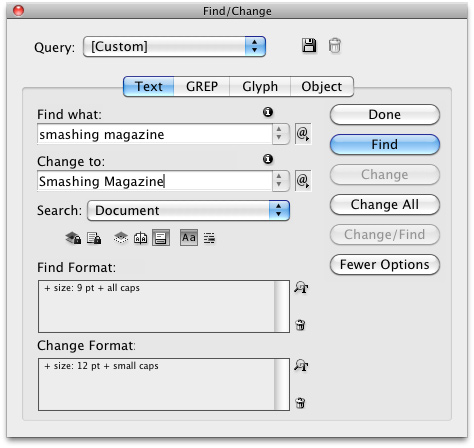고정 헤더 영역
상세 컨텐츠
본문
I am at Macworld in San Francisco and I have seen a product that I guarantee is going to become one of the hottest plug-ins for InDesign.Recosoft Corporation, developers of the PDF2Office family of products has just announced the creation of a PDF to InDesign conversion product that does exactly that! It converts PDF documents into InDesign files.I saw one of the alpha versions of the product in action.The product added an Open PDF file to InDesign’s file menu.It then pointed to the PDF document and opened it.Text in the PDF was converted to text frames. I would be extremely wary of using the word “round-tripping.” It’s very unlikely that an ID document saved to PDF and then re-opened using this plug-in would actually be the same. For example, how could they know if a paragraph had Optical or Metric kerning? There’s no way for them to figure out what’s a nested style. And so on.That said, I sure wish I had seen the plug-in while I was down there, Sandee!
Sounds very cool, and will likely be very useful for many people who need to edit PDF files. (As long as they don’t expect true round-tripping.);). I had exactly the same thought as you, David.It will never be true round tripping.
But it does provide some very good routes for capturing the changes that are made in the PDF document for insertion back into the original ID file.But I see some other, important uses:It provides a cleaner route for translation from Word and other Office PDF documents.It provides a nice start for PDFs captured from web pages to be converted into professional, hi-res documents.Just looking at the menu Open PDF file under the ID File menu made my heart skip a beat. Interesting for sure.
Tips On Adobe Indesign
But for one, text in a PDF files doesn’t flow. Meaning each line is its own paragraph (unless it’s a tagged PDF). Also, even in a tagged PDF file, text boxes are not linked — either within a single page, or across mutliple pages either.
How would they know which text connected to what? Will be interesting to see.Also, a PDF can support multiple page sizes within the same document. InDesign cannot. What happens then? It would make sense if the plugin just made a separate indd file for each page in the PDF.As for the support of transparency, that could mean many things, but would be cool if they could pull it off.Oh, and I agree with David about being wary of using the word “round-tripping” in this sense. Illustrator has had the ability to “round-trip” PDF files since version 9, but it involves trickery on Adobe’s part.In any case, it will be interesting to see if this plugin really delivers. If it does, that means you’d be able to take exisiting Illustrator content and open it in InDesign — that’s far more exciting to me than taking a PDF from Office and opening it in ID.
Sandee, I understand your enthusiasm. I see this as a great way to recover text and graphics to further edit a layout; one thing this should never become is an excuse for print service providers to say “no worries pal, we have pdf2ID so we can correct the pdf that you have given us to print”;-)How many times have I had clients or authors come to me with a pdf and lightheartedly asked for it to be laid out? With a plug-in of this kind issues like these can be overcome in a shorter amount of time.There are also issues about image resolution and compression that make it a less than perfect solution; but hey, I buy into it. From the sounds of the discussion, it sounds like an exported and layered pdf from ID would be the best pdf to start with, as I think Branislav is suggesting in his comment about live transparency.Personally, what I would like to see is have Adobe develop some sort of “package to pdf”.
Adobe Indesign Cs3 Software
Could you imagine that. Being able to receive a “IDCS4 packaged” pdf, that you open in your InDesign CS4 (soon) and it’s every thing you need, all layers preserved. Images have compressed using JPEG 2000 – so they open beautifully. All fonts are there, just like embedding fonts in an Illustrator document.Even better is if you could move that file back and forth between Illustrator and InDesign.Basically what I’m getting at is exactly what Sebastien DiStefano and I chatted about a few years back. Having Adobe turn the CS into a “docu” centred application rather than an “app” centred suite.
Imagine, you create a document, and start opening up modules as needed. Hello Everyone –I’m the Director of Engineering at Recosoft. The company working on the PDF to InDesign conversion tool.I’ve had the opportunity at Macworld to show our tool to Sandy and many other people that stopped. I’ve also read some interesting comments and feedback over here. Any feedback or questions you may have, feel free to direct your email to.We are on track for a April-June 2007 release at present.Just one note – we’ve had many people ask to “Beta” test the software; at present we are not seeking Beta testers.
We’ve been doing PDF conversions to other formats for about 5 years now and we have a very healthy base of users that have signed an NDA with us. We are not expanding it any further at this point.Again, if you have any questions and feedback please send them to us. We’re finalizing the specification of the product in the next couple of weeks for v1.0 and we can add “important” features we haven’t thought of.
It would be very interesting to see what does happen if the converted PDF is indeed converted to indd format with OCG (layers), native transparency, missing fonts, OPI comments, RGB, halftone screens, transfer functions, comments and embedded package data and (let’s say) Forms XObjects and see the resultant PDF from the InDesign PDF Library (1.6 and above). And still passes the new PDF/X4 specification back into Acrobat 8 preflight?Besides that – being sensible, sounds great! (rubbing my worry beads) Jon. This sounds wonderful, and something I’ve dreamed of for ages.
I’ve had a drive die and lost a bunch of.Indd’s although I had the.PDFs I sent the client/printer/publication. With this I could reconstruct the.Indd’s even though a bit of work would be needed. I can think of a dozen other uses as well, but what if Adobe decides to put this function into ID as they should have done years ago? (I guess Recosoft has some sort of arrangement with Adobe and will slip ’em a few mill for it – I’m guessing that’s how these things work?) I suppose I’ll find out in a few days when I have CS3! Yes, it’s always dangerous to announce when software may be released.;) I saw the Recosoft plug-in at The InDesign Conference earlier this month and it was pretty impressive.But it’s very clear that the main use for this is recovery of text and graphics that might have been lost (if the original files were trashed for example). The PDF has no record of things like pararaph style names, names of the placed images, and so on.


/indd-files-591600725f9b586470b96d7a.png)
So all that is lost. You just get locally-formatted text (not necessarily threaded together the way you’d expect) and automatically-generated image names.It’s going to be a huge lifesaver for some folks, but it’s not exactly a “round-trip solution.” PDF just doesn’t record that much info about the originating document.




